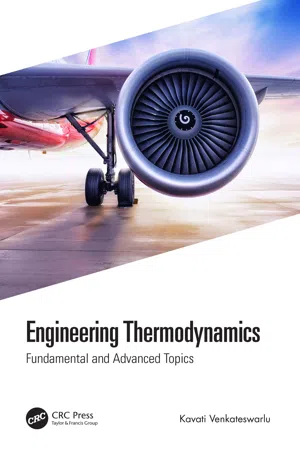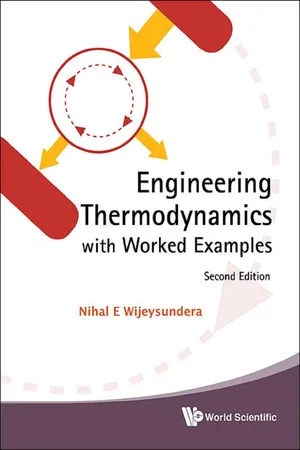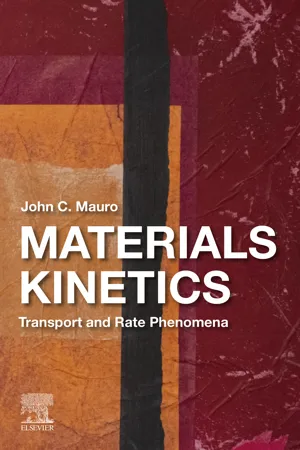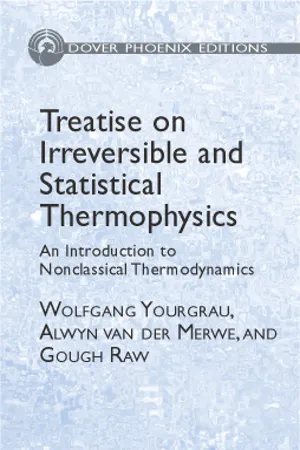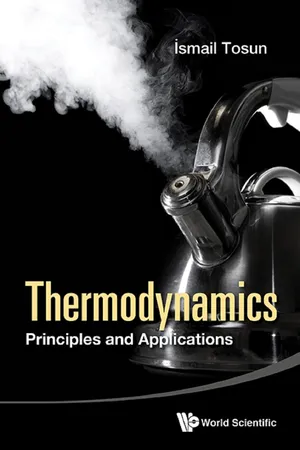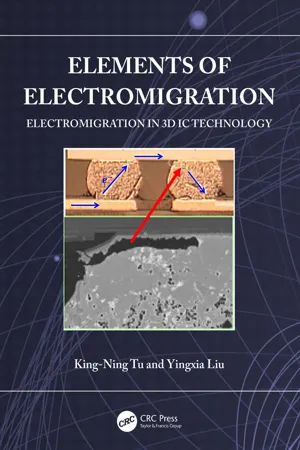Technology & Engineering
Reversible Process
A reversible process in engineering refers to a system or operation that can be reversed without causing any net change in the system or its surroundings. It is a theoretical concept used to analyze the efficiency and performance of engineering systems, such as heat engines and refrigeration cycles. In a reversible process, the system undergoes changes in such a way that it can be returned to its original state with no net effect on the surroundings.
Written by Perlego with AI-assistance
Related key terms
8 Key excerpts on "Reversible Process"
- eBook - ePub
Engineering Thermodynamics
Fundamental and Advanced Topics
- Kavati Venkateswarlu(Author)
- 2020(Publication Date)
- CRC Press(Publisher)
One of the important uses of the second law of thermodynamics in engineering is to determine the best theoretical performance of the systems. By comparing actual performance with the best theoretical performance, an insight can be gained into the potential for improvement. Reversible Processes are essentially important as they provide maximum possible performance (work output) from work-producing devices and minimum work input to the work-consuming devices. The best performance is evaluated in terms of idealized processes. In this section, such idealized processes are introduced and distinguished from actual processes that invariably involve irreversibilities.6.3.1 Reversible Process
It is observed from the second law of thermodynamics that no heat engine is 100% efficient. If that is true, what could be the highest efficiency a heat engine can have. This can be addressed by defining the ideal process based on hypothetical assumptions. The spontaneous processes in nature occur in a certain direction only, the reverse process is not possible spontaneously, and the system cannot be restored to the initial state. Thus, they are called irReversible Processes.A Reversible Process is defined as the one which can be reversed without leaving any trace on the surroundings and at the end of the process, both the system and surroundings are returned to their initial states. If the net heat and net work exchange between system and surroundings for the combined process is zero, then the process is reversible. In both reversible and irReversible Processes, the system can be brought back to its initial state at the completion of a process. Whereas for a Reversible Process, the restoration can be possible without leaving any net change on surroundings, in the case of an irReversible Process, the surroundings do some work on the system and consequently it does not return to the initial state. Some of the processes that tend to be reversible are explained with the following examples: - eBook - ePub
- Nihal E Wijeysundera(Author)
- 2016(Publication Date)
- WSPC(Publisher)
external mechanical irreversibility . In this case, the frictional irreversibility occurs at the boundary between the paddle wheel and the water, which is the system of interest. Here we assume that the temperature and pressure gradients in the water are negligible.The gas expansion following the rupture of the diaphragm in Fig. 6.9 is an internal mechanical irreversibility . The irReversible Process, which in this case, is the free expansion of the gas across a finite pressure difference, occurs inside the system. An internal thermal irreversibility is a heat flow process that takes place due to a finite temperature difference within a system as in Fig. 6.8 . The mixing of the two gases shown in Fig. 6.11 is called a chemical irreversibility .6.4.2Reversible heat engines and thermal reservoirs
The Reversible Process is a useful idealization of real processes that enables us to analyze them conveniently because the properties of the system are spatially uniform at every stage. We now extend this concept to heat engine cycles by defining a reversible heat engine cycle as a cycle in which all the processes are reversible.Therefore the cycle can be completely reversed leaving no permanent effects on the surroundings. The heat and work interactions of the reversed cycle are equal in magnitude but opposite in direction to the corresponding interactions in the direct cycle.A thermal or heat reservoir is an idealized heat source or sink that enables us to carry out heat transfer processes in a reversible manner. It is defined as a body whose mass is such that the absorption or rejection of a quantity of heat of any magnitude will not result in an appreciable change in its temperature or any other thermal property. We define an ideal heat engine cycle as a reversible heat engine operating between a high temperature reservoir and a low temperature reservoir. This cycle is reversible both internally and externally.6.5Some Consequences of the Second Law
We deduced from the K-P-S of the second law that the thermal efficiency of any heat engine has to be less than 100 percent. A question that follows directly is: what is the maximum possible efficiency that a heat engine can have? The answer to this question was provided by a French engineer, Nicolas Leonard Sadi Carnot in 1824. He developed a reversible cycle, commonly known as the Carnot cycle - eBook - ePub
Materials Kinetics
Transport and Rate Phenomena
- John C. Mauro(Author)
- 2020(Publication Date)
- Elsevier(Publisher)
For a system to undergo a Reversible Process, it must never leave equilibrium and must not increase the entropy of the universe. A Reversible Process should occur infinitely slowly and due to an infinitesimally small driving force. Owing to the infinitely slow nature of a Reversible Process, all of the changes that occur in the system are in thermodynamic equilibrium with each other. If the process is also adiabatic, i.e., if the heat content of the system remains constant during the process, then the Reversible Process is also isentropic, meaning that the entropy of the system itself also remains constant. The phenomenon of undergoing a Reversible Process is called reversibility. An example of a hypothetical Reversible Process is shown in Figure 2.1, where a gas is compressed by frictionless mechanical loading of sand, one grain at a time. The process is reversible because the perturbation of a single grain of sand is so small that the system can respond with an infinitesimally small change in its state, never leaving equilibrium. After the sand grains have compressed the gas, the process can be reversed by slowly removing each grain of sand, one at a time. The initial thermodynamic state of the universe is fully recovered after the grains of sand are removed. Of course, Reversible Processes primarily exist in a hypothetical ideal universe. In reality, nearly all processes are irreversible, where the initial state of the universe cannot be restored from the final state. During an irReversible Process, the various intermediate states of the system are not in equilibrium with each other. As a result, the entropy of the universe increases during an irReversible Process and cannot be restored to its initial value. The phenomenon of a system undergoing an irReversible Process is called irreversibility. An example of an irReversible Process is depicted in Figure 2.2, where a gas is compressed suddenly by dropping an anvil - eBook - ePub
- Irving Granet, Jorge Alvarado, Maurice Bluestein(Authors)
- 2020(Publication Date)
- CRC Press(Publisher)
A reversible adiabatic process is isentropic. Isothermal: A process carried out at constant temperature. Principle of the increase of entropy: The entropy of an isolated system increases or in the limit remains the same. Reversible Process: Any process performed so that the system and all its surroundings can be restored to their initial states by performing the process in reverse. Second law of thermodynamics: Heat cannot, of itself, pass from a lower temperature to a higher temperature. Thermal efficiency: The ratio of the net work of a cycle to the heat added to the cycle. Equations Developed in This Chapter Net work output η = net work output heat added × 100 (5.1) Thermal efficiency η = Q in − Q r Q in × 100 = [ 1 − Q r Q in ] × 00 (5.2) Kelvin temperature. function 0 1 Q 2 = T 1 T 2 (5.6) Efficiency of a reversible cycle η = T 1 − T 2 T 1 × 100 [ 1 − T 2 T 1 ] × 100 (5.7a) Entropy Δ S = Q T or Δ s = q T Reversible Process (5.8) Entropy change s 2 − s 1 = c ⋅ ln (T 2 T 1) (5.14) General property. relation T Δ s = Δ u + p Δ v J (5.16) General property relation T Δ s = Δ h + v Δ p J (5.23) General property relation (SI) T Δ s = Δ h − v Δ p (5.23a) Entropy increase principle Δ S ≥ 0 for all isolated systems (5.24) Isentropic efficiency during. compression η compression = w c, s w c, a = h 2, s − h 1 h 2, a − h 1 = Δ h s Δ h a (5.25) Isentropic efficiency during expansion η expansion (turbine) = w t, a w t, s = h 1 − h 2 a h 1 − h 2 s = Δ h a Δ h s (5.26) QUESTIONS 5.1 Can a heat engine do anything other than deliver work? 5.2 Define a cycle. 5.3 Thermal efficiency is defined. to be the ratio of net work to heat added in a cycle. Would you think that this is an appropriate definition to be used when a refrigerator is being discussed? 5.4 Do you know of any process in nature that is reversible? 5.5 There are four distinct events that occur in the Carnot cycle - eBook - ePub
Treatise on Irreversible and Statistical Thermodynamics
An Introduction to Nonclassical Thermodynamics
- Wolfgang Yourgrau, Alwyn van der Merwe, Gough Raw(Authors)
- 2013(Publication Date)
- Dover Publications(Publisher)
overall treatments of physical processes. A detailed discussion deals with quantitative statements about every step of a process, whereas in an overall approach one is content to restrict all quantitative assertions to the process as a whole. The essential limitation of classical thermodynamics may now be expressed by saying that it attains detailed descriptions only for a very special kind of changes—namely, Reversible Processes. Such a process—defined as a concatenation of equilibrium states—is, of course, an idealization to which a real process can at best only approximate in the limit when it is artificially conducted with infinite slowness. This reservation notwithstanding, reversible transformations have been shown to furnish a method for deriving immensely important relationships among thermophysical parameters for different equilibrium situations. Moreover, the concept of a Reversible Process permits overall treatment of many irreversible changes if one mentally substitutes a Reversible Process for a given irreversible transformation. It enables us, for example, to compute the increments of characteristic functions accompanying rapid expansions, chemical reactions, and other irreversible phenomena—no matter how violent or complex they are.However, it should be frankly conceded that traditional theory fails to make quantitative statements concerning the behavior of a system during the course of an irReversible Process—in other words, about the dynamics of thermophysical systems. This theory, which comprises the energy conservation law, the entropy principle, Nernst’s heat theorem, and the unfolding of their consequences, is customarily designated as “thermodynamics” or “classical thermodynamics.” But in view of the emphasis upon equilibrium, or static, states, it is surely more appropriate to talk in this context of thermostatics and reserve the name thermodynamics - eBook - ePub
Thermodynamics
Principles and Applications
- İsmail Tosun(Author)
- 2015(Publication Date)
- WSPC(Publisher)
quasi-static) if it is possible to restore the system and its surroundings to their original states and leave no other effects. For example, consider a closed system undergoing a process from state 1 to state 2 while receiving 1000 J of heat and 800 J of work. If the system can be returned to state 1 along the same path while rejecting 1000 J of heat to its surroundings and doing 800 J of work on the surroundings, then this process is called reversible. Note that a Reversible Process can be completely erased leaving no net effects at all on the physical world.Real processes are all irReversible Processes. For example, you can easily mix vodka and orange juice to prepare a cocktail. Now let us consider reversing the process, i.e., separating vodka from orange juice. Obviously, this requires the use of separation equipment. Some examples of irReversible Processes are given below:• Friction (solid-fluid and solid-solid), • Conversion of energy from one form to another, • Combustion, • Flow through a constriction, such as a partially opened valve, • Free expansion of a gas, • Mixing of fluids, • Flow of electric current through a resistance, • Heat transfer over a finite temperature difference, • Diffusion.Although no real process is completely reversible, some processes can be approximated as reversible if they are executed very slowly, i.e., the driving force is small. For example, consider the heating of a metal block from T1 to T2 by contacting it with a series of heat reservoirs4 at T1 + ΔT, T1 + 2ΔT, …, T2 – ΔT, T2 as shown in Fig. 2.6-a. Is this process reversible or irreversible? To answer this question, it is necessary to reverse the process as shown in Fig. 2.6-b, i.e., the block is cooled from T2 to T1 using the same heat reservoirs. When the block is restored to its initial temperature, note that all the heat reservoirs are also restored to their initial conditions, except for those at T1 and T2 . The reservoir at T1 will have gained a small amount of heat (enough to lower the block temperature from T1 + ΔT to T1 ) and the reservoir at T2 will have lost a small amount of heat (to raise the block temperature from T2 – ΔT to T2 ). It is not possible to completely restore these two reservoirs. However, if ΔT is extremely small, these two reservoirs are approximately back to their initial states. Under these conditions the process is a reversible one. Although heat transfer through a finite temperature difference is always irreversible, by reducing the ΔT - eBook - ePub
Elements of Electromigration
Electromigration in 3D IC technology
- King-Ning Tu, Yingxia Liu(Authors)
- 2024(Publication Date)
- CRC Press(Publisher)
Chapter 5 IrReversible Processes DOI: 10.1201/9781003384281-5 5.1 Introduction During the operation of electronic devices, we can have a flow of matter, a flow of energy (heat), and a flow of charged particles, or all of them together in an open system. From the viewpoint of device reliability, the most important effect is the interactions among them or their cross-effects that can lead to device failure. Especially in electromigration damage in Al and Cu interconnects, it is based on the interaction between atomic flow and electron flow. Furthermore, thermomigration in eutectic flip-chip solder joints is due to the interaction between atomic flow and heat flow, which can lead to phase separation in the eutectic microstructure of the solder alloy. In most cases, these flows are steady. But they may not go from an equilibrium state to another equilibrium state, as in phase transformations. This is because the flow can keep going steadily in an open system. However, without equilibrium end states, we cannot use the condition of minimum Gibbs free energy to describe the process. In a steady state of flows, we are in the domain of non-equilibrium thermodynamics or irReversible Processes [ 1, 2, 3 and 4 ]. In classical thermodynamics, the kinetic process going from one equilibrium state to another equilibrium state can be reversible or irreversible. Theoretically, it can be reversible. Practically, all of them tend to be irreversible. To demonstrate the difference between a reversible and an irReversible Process, Figure 5.1a depicts a closed system where a container contains water and vapour at constant temperature and constant pressure. The water and the vapour are at equilibrium, meaning that across the interface between them, there is an exchange of molecules of water and vapour, and the exchange is at micro-balance - eBook - ePub
Applied Thermodynamics
Availability Method And Energy Conversion
- Kam W. Li(Author)
- 2018(Publication Date)
- CRC Press(Publisher)
Figure 2-3 indicates the difference between the reversible and irreversible heat transfer processes from body A to body B. While the actual heat transfer process is characterized by a finite temperature difference, the reversible heat transfer process is characterized by an infinite number of fictitious bodies between the actual bodies A and B, each fictitious body performing heat source and sink functions and reducing the temperature by an infinitesimal amount in the direction of heat flow. Like the quasi-static process, the reversible heat transfer process is an ideal process.Figure 2-3 Reversible and irreversible heat transfer processes: (a) irreversible heat transfer, (b) reversible heat transfer processFigure 2-4 shows a hot body being cooled in its environment. This actual heat transfer process is not reversible. To make the process entirely reversible, one can install a Carnot engine between the hot body and the environment. Because the Carnot engine is a reversible device, all processes in the Carnot system must be reversible. In other words, the hot body loses heat to its environment by δQh in a Reversible Process and, as a result, produces reversible work of δWc (i.e., Carnot work). If the hot body has a finite capacity and its temperature is decreased in the heat transfer process, one can make the process reversible by using an infinite number of Carnot engines between the hot body and its environment, one engine operating at a time and having the hot-body temperature reduced by an infinitesimal amount. The sum of all these Carnot engine outputs will be the reversible work in this process.Figure 2-4 Reversible and irreversible heat transfer process between a hot body and its environment.Figure 2-5(a) presents a typical heat exchanger in which heat is transferred from a high temperature stream to a low temperature stream. The heat transfer process can be made entirely reversible by placing an infinite number of Carnot engines between the streams. As shown in Fig. 2-5(b)
Index pages curate the most relevant extracts from our library of academic textbooks. They’ve been created using an in-house natural language model (NLM), each adding context and meaning to key research topics.
